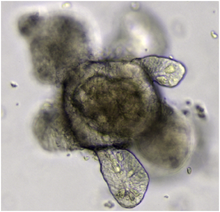
An organoid is a miniaturised and simplified version of an organ produced in vitro in three dimensions that mimics the key functional, structural, and biological complexity of that organ.[1] It is derived from one or a few cells from a tissue, embryonic stem cells, or induced pluripotent stem cells, which can self-organize in three-dimensional culture owing to their self-renewal and differentiation capacities. The technique for growing organoids has rapidly improved since the early 2010s, and The Scientist named it one of the biggest scientific advancements of 2013.[2] Scientists and engineers use organoids to study development and disease in the laboratory, for drug discovery and development in industry,[3] personalized diagnostics and medicine, gene and cell therapies, tissue engineering, and regenerative medicine.
- ^ Zhao Z, Chen X, Dowbaj AM, Sljukic A, Bratlie K, Lin L, et al. (2022). "Organoids". Nature Reviews. Methods Primers. 2. doi:10.1038/s43586-022-00174-y. PMC 10270325. PMID 37325195.
- ^ Grens K (December 24, 2013). "2013's Big Advances in Science". The Scientist. Retrieved 26 December 2013.
- ^ Mullard A (March 2023). "Mini-organs attract big pharma". Nature Reviews. Drug Discovery. 22 (3): 175–176. doi:10.1038/d41573-023-00030-y. PMID 36797431.